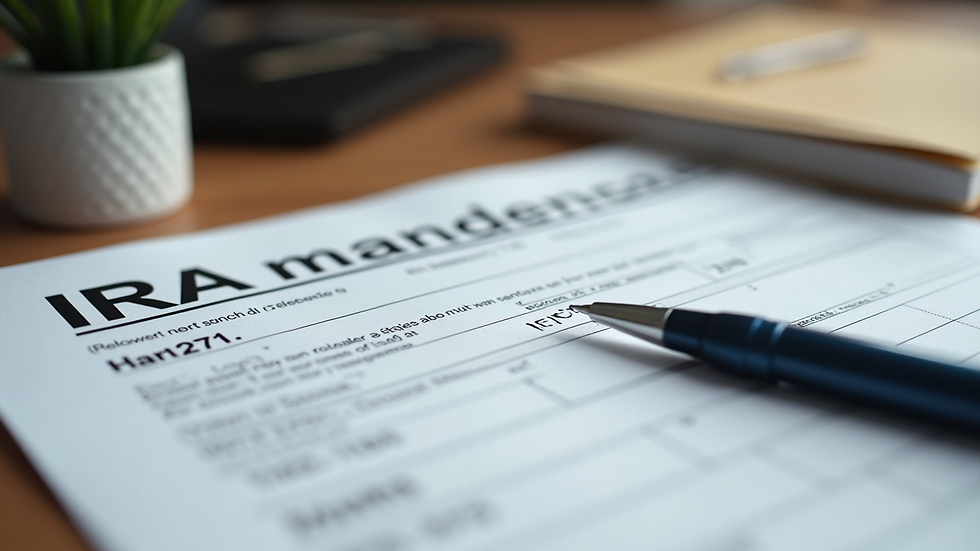Maximizing Tax Benefits with Qualified Charitable Distributions
- T&G

- Aug 10
- 4 min read
When you think about giving to charity, you probably focus on the joy of helping others. But did you know that your generosity can also bring you significant tax benefits? If you are 70 ½ or older, there is a powerful tool called qualified charitable distributions that can help you maximize your giving while reducing your tax burden. In this post, I will walk you through how to use this strategy effectively, share practical tips for tax-efficient charitable giving, and explain why it might be better than a standard charitable deduction.
Understanding Tax-Efficient Charitable Giving Tips
Giving to charity is a wonderful way to support causes you care about. But if you want to be smart about it, you need to understand how your donations affect your taxes. Here are some tax-efficient charitable giving tips that can help you make the most of your generosity:
Give from your IRA if you are 70 ½ or older: This is where qualified charitable distributions come in. Instead of taking a required minimum distribution (RMD) and then donating that money, you can direct your IRA custodian to send the funds directly to a qualified charity. This reduces your taxable income.
Keep good records: Always get a receipt or written acknowledgment from the charity. This is essential if you itemize deductions.
Consider bunching donations: If your total charitable gifts are close to the standard deduction limit, you might benefit from bunching several years’ worth of donations into one year to maximize itemized deductions.
Choose appreciated assets: Donating stocks or mutual funds that have increased in value can help you avoid capital gains taxes while still getting a deduction for the full market value.
By following these tips, you can give generously and keep more of your money working for you.

How Qualified Charitable Distributions Work
Qualified charitable distributions (QCDs) are a special way to give directly from your IRA to a charity. Here’s how they work:
You must be at least 70 ½ years old.
You can transfer up to $100,000 per year directly from your IRA to a qualified charity.
The amount transferred counts toward your required minimum distribution (RMD) for the year.
The distribution is excluded from your taxable income, which can lower your overall tax bill.
For example, if you are required to take a $10,000 RMD but you donate $5,000 directly to a charity via a QCD, you only have to pay taxes on the remaining $5,000. This can be especially helpful if you do not itemize deductions because the QCD reduces your taxable income without needing to claim a deduction.
It’s important to note that QCDs only apply to IRAs, not 401(k)s or other retirement accounts. Also, the charity must be a qualified 501(c)(3) organization.

Is a QCD Better Than a Charitable Deduction?
You might wonder if it’s better to take a QCD or simply claim a charitable deduction on your tax return. The answer depends on your individual tax situation, but here are some key points to consider:
Standard deduction vs. itemizing: Many taxpayers take the standard deduction, which means they do not benefit from itemizing charitable donations. A QCD reduces your taxable income directly, so it benefits you even if you do not itemize.
Lowering taxable income: Because a QCD is excluded from income, it can help reduce your adjusted gross income (AGI). A lower AGI can mean lower Medicare premiums and less taxation on Social Security benefits.
Avoiding capital gains tax: If you donate appreciated assets, you can avoid capital gains tax, but this requires itemizing deductions. A QCD does not require itemizing and still provides tax benefits.
Simplicity: A QCD is a straightforward way to give directly from your IRA without having to handle the money yourself.
In many cases, a QCD offers more tax advantages than a charitable deduction, especially for those who do not itemize or want to reduce their taxable income.

Practical Steps to Make a Qualified Charitable Distribution
If you decide to use a QCD, here are the practical steps to follow:
Confirm your eligibility: Make sure you are 70 ½ or older and have an IRA account.
Choose your charity: Verify that the charity is qualified under IRS rules.
Contact your IRA custodian: Request a direct transfer of funds from your IRA to the charity. Do not withdraw the money yourself and then donate it.
Keep documentation: Obtain a receipt from the charity showing the amount received.
Report the QCD on your tax return: Your IRA custodian will send you a Form 1099-R showing the distribution. You will report the distribution but exclude the QCD amount from your taxable income.
By following these steps, you can ensure your donation is handled correctly and you receive the full tax benefit.
Protecting Your Legacy and Assets with Smart Giving
Using qualified charitable distributions is not just about saving on taxes today. It’s also a smart way to protect your assets and ensure your wishes are honored. When you give directly from your IRA, you reduce the size of your taxable estate. This can help your heirs avoid higher estate taxes and probate complications.
At Troyer & Good, PC, we understand how important it is to plan your estate carefully. Combining charitable giving strategies with powers of attorney, health care directives, and living wills can create a comprehensive plan that protects you and your family.
If you want to explore how charitable giving fits into your overall estate plan, consider consulting with a trusted legal advisor. They can help you navigate the complex rules and make sure your giving aligns with your goals.
Maximizing your tax benefits through charitable giving is within your reach. By using qualified charitable distributions and following tax-efficient giving tips, you can support the causes you care about while keeping more of your money. Take control of your giving today and make a lasting impact.




Comments